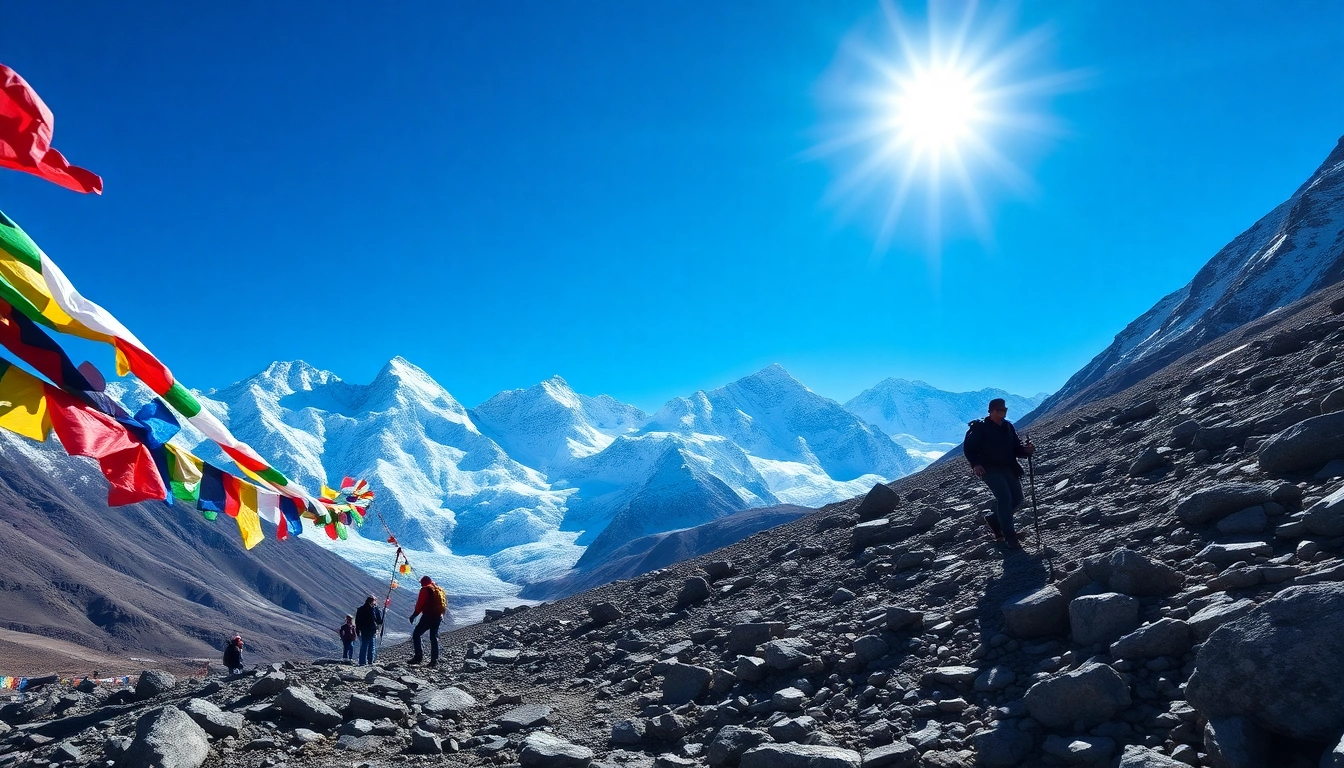Introduction to Everest Base Camp Trek
Overview of Trekking to Everest Base Camp
The Everest Base Camp Trek is a legendary journey that captures the imagination of adventure enthusiasts and nature lovers alike. Nestled in the breathtaking Khumbu region of Nepal, this trek offers a unique opportunity to walk in the footsteps of legendary mountaineers, surrounded by some of the highest peaks on Earth. Spanning approximately 130 kilometers round trip, the trek to Everest Base Camp lures trekkers with its stunning landscapes, rich Sherpa culture, and the promise of unparalleled views of Mount Everest, the world’s tallest peak at 8,848 meters.
For many, the ultimate goal of reaching the base camp, located at a staggering 5,364 meters, represents the pinnacle of achievement and outdoor exploration. By immersing themselves in the natural beauty and cultural richness of the region, trekkers embark on a journey filled with unforgettable experiences, breathtaking vistas, and personal growth. With detailed planning and determination, anyone can undertake the Everest Base Camp Trek.
Why Adventure Enthusiasts Choose Everest Base Camp Trek
The allure of the Everest Base Camp Trek is multifaceted. It attracts adventurers for various reasons, whether seeking an adrenaline rush, cultural enrichment, or spiritual awakening. Here are several key factors that inspire trekkers:
- Stunning Natural Beauty: The trek provides breathtaking views of iconic peaks such as Lhotse, Nuptse, and Ama Dablam, showcasing the majestic Himalayas in their full glory.
- Cultural Immersion: Trekkers engage with the rich Sherpa culture, visiting ancient monasteries, local villages, and experiencing the hospitality of the Sherpa people.
- Achieving Personal Goals: For many, reaching Everest Base Camp symbolizes overcoming physical and mental challenges, fostering a sense of accomplishment and personal growth.
- Community and Camaraderie: Trekking is often a communal experience where trekkers bond with fellow adventurers, sharing stories and forging friendships.
Understanding the Experience of the Everest Base Camp Trek
The experience of the Everest Base Camp Trek is not solely about reaching the destination; it is equally about the journey. Trekkers encounter diverse landscapes, from lush valleys and pine forests to rocky terrains and high-altitude glaciers. The route is dotted with quaint villages that provide a window into the Sherpa way of life, and tea houses (local lodges) offer a chance to rest while enjoying traditional meals.
As trekkers ascend, they experience significant altitude changes, requiring acclimatization and mindfulness of their physical condition. The natural elements can also present challenges, from unpredictable weather to varying trail conditions, highlighting the importance of preparation and respect for the mountain environment.
Planning Your Everest Base Camp Trek
Best Time for Everest Base Camp Trek
Choosing the right time for your Everest Base Camp Trek is critical to ensuring a safe and enjoyable experience. The best months to trek are generally from late February to early May and from late September to early November. These periods offer clear skies, mild weather conditions, and relatively stable temperatures. Here’s a closer look at each season:
- Spring (March to May): This period witnesses the most trekkers, as temperatures are warmer, and flowers blossom across the trails. However, it’s essential to book your trek in advance due to high demand.
- Autumn (September to November): The trails are quieter than in spring, providing a more tranquil trekking experience. The weather remains stable, but temperatures begin to drop as winter approaches.
- Winter (December to February): While possible to trek, these months are less popular due to harsh weather conditions and heavy snowfall, leading to trail closures and extreme temperatures.
- Monsoon (June to August): The monsoon season brings heavy rains, making trails muddy and slippery. It is generally advised to avoid trekking during this period due to safety concerns.
Preparing for Your Everest Base Camp Trek
Preparation is paramount for a successful Everest Base Camp Trek. It involves not only physical conditioning but also mental readiness and logistical organization. Here are some essential steps for effective preparation:
- Physical Training: Focus on building endurance and strength through cardio workouts, hiking, and strength training exercises. Aim for at least three months of training leading up to your trek.
- Altitude Acclimatization: Gradually exposure to higher altitudes is crucial. Incorporate gradually increasing elevation hikes into your training routine.
- Mental Preparation: Trekking can be mentally taxing, so cultivate a positive mindset and adaptability to changing conditions. Visualization techniques and mindfulness can be beneficial.
- Logistical Organization: Plan the duration of your trek and secure a reliable guide or trekking company to ensure safety and ease along the way.
Essential Packing List for Everest Base Camp Trek
Having the right gear is essential for safety and comfort on the Everest Base Camp Trek. Here’s a comprehensive packing list to consider:
- Clothing: Layered clothing, including moisture-wicking base layers, insulating mid-layers, and waterproof outer layers. Don’t forget thermal underwear, a hat, gloves, and a warm jacket.
- Footwear: Invest in high-quality trekking boots that provide ankle support and are broken in prior to the hike. Include sturdy socks and camp shoes.
- Sleeping Gear: A lightweight sleeping bag rated for cold temperatures as well as a sleeping pad for extra insulation.
- Personal Items: Sunscreen, lip balm with SPF, first aid kit, water purification tablets, and personal hygiene items.
- Navigation Tools: Maps, a compass, and a GPS device or tracking application on your phone.
- Cameras: Capture the stunning landscapes with a camera or smartphone with sufficient storage and battery life.
Itinerary Breakdown for Everest Base Camp Trek
Day-by-Day Guide for the Everest Base Camp Trek
The Everest Base Camp Trek is typically completed over 12 to 14 days. Here’s a sample day-by-day breakdown of the trek:
- Day 1: Fly from Kathmandu to Lukla (2,840m), then trek to Phakding (2,610m).
- Day 2: Trek from Phakding to Namche Bazaar (3,440m), encountering stunning mountain vistas.
- Day 3: Acclimatization day in Namche. Explore local sights or hike to Everest View Hotel.
- Day 4: Trek from Namche to Tengboche (3,860m), home to a famous monastery.
- Day 5: Trek to Dingboche (4,410m), gaining altitude as you progress.
- Day 6: Acclimatization day in Dingboche; possible hike to Nagarjun Hill for panoramic views.
- Day 7: Trek from Dingboche to Lobuche (4,940m).
- Day 8: Trek to Gorak Shep (5,170m), drop off bags, then hike to Everest Base Camp (5,364m).
- Day 9: Hike to Kala Patthar (5,545m) for sunrise views, then descend back to Gorak Shep.
- Day 10: Trek back to Pheriche (4,371m).
- Day 11: Continue trekking back to Namche Bazaar.
- Day 12: Trek from Namche to Lukla. Celebrate the completion of the trek!
- Day 13: Fly back to Kathmandu from Lukla.
Highlights and Must-See Stops on the Trek
The Everest Base Camp Trek is punctuated by a series of highlights that should not be missed. Some of the must-see stops include:
- Namche Bazaar: A vibrant Sherpa town that serves as an acclimatization hub and offers stunning mountain views.
- Tengboche Monastery: One of the most significant monasteries in the region, known for its cultural heritage and panoramic views of the Himalayas.
- Gorak Shep: The last settlement before Everest Base Camp, serving as a crucial stop for trekkers.
- Kala Patthar: Renowned for its breathtaking sunrise views over Mount Everest, this viewpoint is a highlight for many trekkers.
Accommodation Options during Everest Base Camp Trek
During the Everest Base Camp Trek, accommodation primarily consists of tea houses. These provide basic amenities, including food and lodging. The options vary in comfort level, but here’s a general overview:
- Tea Houses: Most trekkers stay in locally-owned tea houses that offer a bed and meals. It’s essential to book in advance during peak seasons.
- Lodges: Some areas have more established lodges equipped with better facilities, including hot showers and Wi-Fi.
- Camping: For those preferring a more intimate experience with nature, camping may also be arranged, but it requires organizing with a trekking company.
Challenges and Tips for the Everest Base Camp Trek
Altitudinal Considerations for the Everest Base Camp Trek
One of the primary challenges of the Everest Base Camp Trek is altitude sickness. As trekkers ascend, the oxygen levels diminish, leading to potential altitude-related issues. It’s vital to recognize the symptoms of altitude sickness, which can include headaches, nausea, dizziness, and difficulty sleeping. To mitigate these risks:
- Acclimatize adequately by allowing your body to adjust to higher altitudes.
- Stay hydrated and maintain a balanced diet.
- Consider descending if experiencing severe symptoms.
Safety Tips for Trekking to Everest Base Camp
Safety should always be paramount during extreme trekking experiences. Here are some essential safety tips:
- Travel with a reputable guide or agency familiar with the terrain and local conditions.
- Keep an emergency contact list and familiarize yourself with local medical facilities along the trek.
- Stay informed about weather forecasts and be prepared for sudden changes in conditions.
- Utilize appropriate gear, including helmets when crossing potentially hazardous areas or glaciers.
Dealing with Weather Conditions of Everest Base Camp Trek
Weather conditions can significantly influence the trekking experience. Understanding what to expect helps in better preparation and adaptation:
- Be prepared for rapidly changing weather, especially at high altitudes. Carry both waterproof and thermal clothing.
- Track local weather patterns, as significant snowfall or storms can disrupt treks and lead to trail closures.
- Plan rest days in your itinerary to account for any weather-related delays, ensuring flexibility remains in your schedule.
Experiencing Sherpa Culture on the Everest Base Camp Trek
Interaction with Local Communities During Everest Base Camp Trek
The Everest Base Camp Trek offers a rare glimpse into the rich and vibrant culture of the Sherpa people. Trekking through their villages presents opportunities to engage with locals and immerse oneself in their traditions. Potential experiences include:
- Visiting local schools and monasteries, gaining insights into education and spiritual practices.
- Participating in village festivals, should they coincide with your trek schedule, offering a genuine experience of cultural celebrations.
- Learning about traditional crafts and skills, including weaving and wood carving.
Culinary Highlights of the Everest Base Camp Trek
A trek to Everest Base Camp is also a culinary journey. While the teahouses serve classic Nepali dishes, trekkers can explore unique flavors and traditional meals, including:
- Dhal Bhat: A staple meal of lentil soup served with rice and vegetables, providing the necessary energy for daily hikes.
- Thukpa: A hearty noodle soup that warms trekkers, especially at high elevations.
- Yak Meat: An indigenous delicacy often featured in dishes such as yak burgers or steaks.
Understanding the Spiritual Aspects of the Everest Base Camp Trek
The region around Everest is steeped in spiritual significance. Many trekkers find themselves captivated by the serene atmosphere, leading to moments of introspection and spiritual connection. Key spiritual aspects include:
- Buddhism: The presence of monasteries and prayer flags throughout the trek creates a peaceful environment, fostering mindfulness and reflection.
- Nature as Sacred: Many locals view the mountains as sacred spaces, a belief that enhances the trekking experience and deepens respect for the land.
- Personal Reflection: The journey becomes a metaphor for personal growth, where trekkers confront their limitations and discover a sense of purpose.



